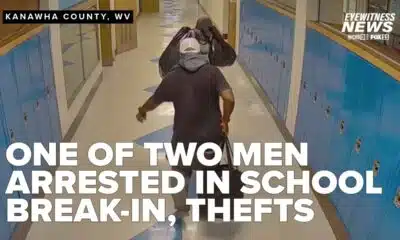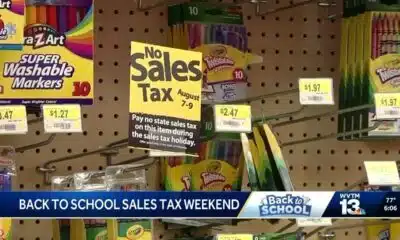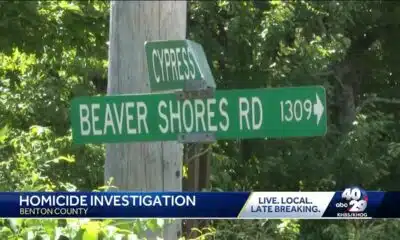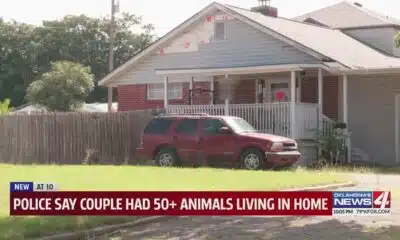News from the South - Texas News Feed
Abbott: Texas voters should weigh in on every tax increase
Gov. Greg Abbott wants to set a high bar for local tax increases
“Gov. Greg Abbott wants to set a high bar for local tax increases” was first published by The Texas Tribune, a nonprofit, nonpartisan media organization that informs Texans — and engages with them — about public policy, politics, government and statewide issues.
Sign up for The Brief, The Texas Tribune’s daily newsletter that keeps readers up to speed on the most essential Texas news.
DALLAS — Gov. Greg Abbott, in his bid to curb Texas’ high property taxes, wants Texas voters to have the final say on any property tax hike.
Local governments that collect property taxes — including cities, counties and school districts — should have to win approval from a two-thirds majority of voters if they want to raise their tax rates, Abbott said.
“No approval, no new taxes,” he said earlier this month during his State of the State address.
Putting every proposed tax rate increase before the voters would have widespread implications for localities’ ability to keep up with demand for services as the state booms, local officials, school advocates and tax policy experts said. As Texas’ population grows, so does the need for roads, schools and public safety, they said. Requiring any tax increase to clear a two-thirds majority vote is a nearly impossible task — and would make it easy to kill any measure aimed at providing basic services.
“We have to respect the people’s vote,” Austin Mayor Kirk Watson, a former state senator, said. “We shouldn’t create a system that allows a minority to thwart what the will of the majority wants.”
Such a requirement could further complicate school districts’ finances. As Texas has boomed and state funding to public schools has stagnated, school districts have increasingly turned to voters to help them boost teacher pay and cover basic costs among other initiatives, said Kevin Brown, executive director of the Texas Association of School Administrators.
[Abbott’s political muscle puts his agenda on fast track in Legislature]
“All of the things that we all see in our own lives, schools are dealing with that, too,” said Brown, a former Alamo Heights ISD superintendent. “But they’re doing it without increased resources from the state.”
The proposal also struck some as an outcropping of a yearslong campaign by Abbott and Texas Republicans to sap authority from the state’s cities and counties, often run by Democrats. But even local officials from Republican-controlled parts of the state aren’t happy with Abbott’s idea.
“While we share the goal of property tax relief, these mandates would harm effective local governance,” Rockwall Mayor Trace Johannesen wrote in a letter to Abbott posted on the social media site X.
Local governments in less populated areas of the state that already have lower property values could see disproportionate effects. Lower and slower growing property values mean taxes often don’t keep up with inflation. That makes providing basic services more expensive.
In East Texas, Angelina County Judge Keith Wright, a Republican, said he was waiting to see legislation that would codify Abbott’s idea. However, he has already expressed concerns to state lawmakers.
“Any such proposal could possibly be devastating to rural counties outside of metroplex areas,” he said.
Texans pay among the highest property taxes in the country because the state doesn’t have an income tax and relies heavily on property taxes to provide services like police and fire protection, public schools, streets and sidewalks. For the past six years, GOP lawmakers have pushed to rein in rising property tax bills — spending tens of billions of dollars on the effort. But the state’s property taxes remain high and legislators this year will once more consider ways to bring relief to homeowners and businesses.
“Republicans have been in charge of state government for almost 30 years, and they’re running short of ideas for how to bring down Texas’s already high property taxes,” said Brandon Rottinghaus, a political scientist at the University of Houston. “They’ve been hearing the yelp from the public for multiple decades about how property taxes are high, and they are desperate to find some way to put limits on that growth. I think part of it is that they’re stretched thin on ideas for how to slow down local property taxes.”
The inciting incident for Abbott: Harris County commissioners opted last year to raise their overall tax rate by about 14% to help pay for the costs of responding to three major weather events, including Hurricane Beryl.
Texas already limits how much more local governments can increase their property tax revenue t each year — a mechanism intended to contain property tax bills by forcing localities to lower their rates as property values rise. If localities want to raise more revenue than that cap allows, they have to ask voters for permission.
Local tax rates have generally fallen since state lawmakers tightened that cap in 2019. Tax-cut advocates have credited that move with slowing the growth of property tax bills, while local officials say the law has made it harder for localities to raise the funds necessary to deliver basic services.
There’s a carveout in the law that allows local officials to raise tax revenue past that limit if they have to use the funds to respond to a disaster like a flood or hurricane — each of which the Houston area experienced last year. Harris County used that carveout to pursue a tax rate increase without going to the voters. Officials said the funds would go toward paying for the county’s response to those weather events and prepare for future ones.
The average Harris County homeowner’s overall property tax bill rose about 5% following the hike in the county’s overall tax rate, according to a Texas Tribune analysis. But that homeowner’s bill was about 13% lower than it was before the COVID-19 pandemic when adjusted for inflation.
Houston-area Republicans balked at the increase and called it an abuse of the carveout, though Abbott had issued a disaster declaration in Beryl’s aftermath that covered Harris County.
“What happened is Harris County took a Mack truck through that disaster exemption on a Category 1 storm,” said state Sen. Paul Bettencourt, a Houston-area Republican.
Representatives for Harris County Judge Lina Hidalgo did not respond to requests for comment.
Some GOP legislators have filed bills to repeal the carveout. Bettencourt said he’s tinkering with legislation to perhaps tie the amount localities could raise taxes in a disaster scenario to, for example, directly to costs they incurred resulting from the disaster.
Abbott’s proposal would go beyond tax increases following disasters.
Many tax-rate elections and bond proposals that won with a majority of voters on last November’s ballot would not have cleared Abbott’s proposed threshold, according to a Tribune review of election records.
Travis County voters in November approved local tax increases to boost teacher pay and fund child care. But neither passed with a two-thirds majority of voters.
Together, those measures drove a 9.3% increase in the average homeowner’s tax bill in 2024, according to figures from the Travis County tax office. When adjusted for inflation, that homeowner’s bill remained slightly below where it stood just prior to the pandemic.
Forcing every proposed tax-rate increase or bond election to obtain approval from two-thirds of voters could have other negative effects, local officials and policy experts warn. Localities, they said, would likely face higher borrowing costs when seeking bonds to finance the construction of public schools, roads and other infrastructure because they wouldn’t have as much flexibility to collect tax revenue — resulting in higher costs for local taxpayers.
Some Texas cities like Austin, Houston and Dallas each face growing financial challenges in the coming years, in part because of the state’s existing limits on how much revenue localities can raise. It’s likely that those cities would face further financial pain should the state make it harder to raise tax rates, said John Diamond, senior director of the Center for Public Finance at the Baker Institute for Public Policy at Rice University.
There are other ways to reduce property tax burdens, said Kamolika Das, a tax policy analyst at the left-leaning Institute on Taxation and Economic Policy.
Texas could, as many other states do, cap property tax bills when they reach a certain level, Das said. About 30 states and the District of Columbia have programs known as “circuit breakers” that give taxpayers a credit or rebate when that happens, according to the Lincoln Institute of Land Policy, a Massachusetts-based think tank. Texas lawmakers have occasionally floated and abandoned such an idea, citing the projected cost of administering such a program.
“If the goal is to be supporting people who are having trouble paying their property taxes, there are just much better ways to do that than an across-the-board cut,” Das said.
Bettencourt, one of the Legislature’s chief tax-cut proponents, stopped short of embracing Abbott’s idea to have voters weigh in on every proposed tax increase. He noted he authored the provision in state law that allows localities to raise taxes past a certain amount if they get voter approval.
“I’m a big proponent of people voting on tax increases,” Bettencourt said. “I’m not sure a constant barrage is the right way to do it. You want the public to be involved in things that are outside the norm.”
— Jess Huff contributed.
Disclosure: Rice University, Rice University’s Baker Institute for Public Policy, Texas Association of School Administrators and University of Houston have been financial supporters of The Texas Tribune, a nonprofit, nonpartisan news organization that is funded in part by donations from members, foundations and corporate sponsors. Financial supporters play no role in the Tribune’s journalism. Find a complete list of them here.
This article originally appeared in The Texas Tribune at https://www.texastribune.org/2025/02/10/greg-abbott-property-taxes-voters/.
The Texas Tribune is a member-supported, nonpartisan newsroom informing and engaging Texans on state politics and policy. Learn more at texastribune.org.
News from the South - Texas News Feed
Scammers target volunteer fire department helping flood victims
SUMMARY: The Office of Attorney General Ken Paxton is investigating scammers who targeted the Center Point Volunteer Fire Department’s flood relief fundraiser after the devastating July 4 flood in Kerr County, which caused over 100 deaths. Scammers created fake Venmo accounts to divert donations, though Venmo shut them down quickly. Paxton vowed to use full authority against such fraud. The fire department’s genuine fundraiser continues via GoFundMe and mail donations. The Better Business Bureau warns of sophisticated AI-driven scams cloning websites and hijacking links. Donors are urged to verify payment sites, avoid wiring money, research charities, and be cautious of urgent appeals to prevent fraud.
The post Scammers target volunteer fire department helping flood victims appeared first on www.kxan.com
News from the South - Texas News Feed
Democratic doctor challenging GOP Rep. Monica De La Cruz
“Harlingen doctor becomes first Democrat to challenge GOP Rep. Monica De La Cruz for South Texas congressional seat” was first published by The Texas Tribune, a nonprofit, nonpartisan media organization that informs Texans — and engages with them — about public policy, politics, government and statewide issues.
Sign up for The Brief, The Texas Tribune’s daily newsletter that keeps readers up to speed on the most essential Texas news.
Ada Cuellar, a Harlingen-based emergency physician, launched her campaign for Texas’ 15th Congressional District on Thursday, becoming the first Democrat to run for the South Texas seat that her party is targeting in the 2026 midterms.
Anchored in Hidalgo County along the border and running north to the edge of San Antonio, the district — represented by Rep. Monica De La Cruz, R-Edinburg — has been emblematic of Democrats’ recent struggles throughout the Rio Grande Valley and with Latino voters generally. De La Cruz first won office in 2022, becoming the first Republican to represent the district after it was redrawn to favor Republicans.
The seat has been in Democrats’ crosshairs ever since. But South Texas was the epicenter of a national rightward shift in 2024 among Latinos, who make up about three-quarters of the 15th District’s eligible voting-age population, according to U.S. Census Bureau data. President Donald Trump was the first Republican to win Hidalgo County in decades, improving from a 28% vote share in 2016 to 51% last year.
Whoever wins the Democratic nomination will likely face an uphill battle. De La Cruz won reelection by 14 points in 2024, despite the Democratic Congressional Campaign Committee and other national groups targeting it as a potential pickup. The district leans Republican by a 7-point margin, according to the Cook Partisan Voting Index.
While Cuellar — who has no relation to Rep. Henry Cuellar, D-Laredo — is the first candidate to officially announce, Tejano music star Bobby Pulido has also been floated as a potential candidate. Pulido said he planned to enter politics in 2026, and he has been heavily recruited by Democrats, according to Politico.
Cuellar lives outside the district boundary, in the district of Rep. Vicente Gonzalez, D-McAllen. She is from Weslaco and went to college in Edinburg.
Members of Congress do not have to live in the district they represent, though residing outside the boundaries can open candidates to attacks from their opponents.
De La Cruz is the only Texas Republican the DCCC currently lists among its 2026 targets. But the spectre of redistricting, which could put more seats in play and upend the state’s political map, is hanging over both parties. South Texas is a key area where Republican map-drawers will likely try to draw friendlier seats by targeting De La Cruz’s Democratic neighbors, meaning the contours of the 15th District could change.
Under any new map, the district’s population is likely to remain overwhelmingly Hispanic — meaning Democrats will need to reverse their recent slide to have any chance of recapturing the seat.
Cuellar, a 43-year-old Rio Grande Valley native, believes Latino voters, in particular, were looking for change last cycle as they felt the bite of high costs fueled by inflation. She believes Democrats can position themselves as the party of change in 2026, especially on issues like health care, after Republicans including De La Cruz voted for Medicaid cuts as part of Trump’s recently enacted megabill.
“People are frustrated with health care costs, inflation, the economy, how difficult it is to succeed,” Cuellar said. “And I think a lot of frustrations were directed towards the Democratic Party.”
National Republicans expressed confidence they would hold onto the seat.
“Monica De La Cruz remains a steadfast advocate for the people of South Texas, consistently delivering commonsense results,” Zach Bannon, a spokesperson for the National Republican Congressional Committee, said in a statement. “Voters are eager to send her back to Washington to continue her work and will resoundingly reject any out of touch Democrat in the race.”
Democrats flipped the U.S. House in 2018 — including through pickups in Texas — largely by talking about Republicans’ efforts to quash the Affordable Care Act. Democrats hope to follow a similar playbook in 2026 by homing in on the Medicaid and ACA cuts in the megabill. Groups have been actively recruiting physicians like Cuellar to run for office as part of that pitch.
During her campaign, Cuellar said she also plans to discuss the need for a county hospital and more doctors in the district, along with plans to make health care more affordable.
Disclosure: Politico has been a financial supporter of The Texas Tribune, a nonprofit, nonpartisan news organization that is funded in part by donations from members, foundations and corporate sponsors. Financial supporters play no role in the Tribune’s journalism. Find a complete list of them here.
The lineup for The Texas Tribune Festival continues to grow! Be there when all-star leaders, innovators and newsmakers take the stage in downtown Austin, Nov. 13–15. The newest additions include comedian, actor and writer John Mulaney; Dallas mayor Eric Johnson; U.S. Sen. Amy Klobuchar, D-Minnesota; New York Media Editor-at-Large Kara Swisher; and U.S. Rep. Veronica Escobar, D-El Paso. Get your tickets today!
TribFest 2025 is presented by JPMorganChase.
This article originally appeared in The Texas Tribune at https://www.texastribune.org/2025/07/17/ada-cuellar-democrat-monica-de-la-cruz-south-texas-congress/.
The Texas Tribune is a member-supported, nonpartisan newsroom informing and engaging Texans on state politics and policy. Learn more at texastribune.org.
The post Democratic doctor challenging GOP Rep. Monica De La Cruz appeared first on feeds.texastribune.org
Note: The following A.I. based commentary is not part of the original article, reproduced above, but is offered in the hopes that it will promote greater media literacy and critical thinking, by making any potential bias more visible to the reader –Staff Editor.
Political Bias Rating: Center-Left
This article from The Texas Tribune leans Center-Left, primarily due to its emphasis on Democratic perspectives, framing of Republican actions, and favorable attention to Democratic candidate Ada Cuellar’s campaign. While the article includes factual data and references to Republican figures like Rep. Monica De La Cruz, the narrative highlights Democratic strategies, critiques of Republican policies (especially Medicaid cuts), and Cuellar’s policy priorities without equally presenting counterpoints from her Republican opponent. The language is measured and journalistic, but the thematic focus and selection of quotes subtly favor Democratic viewpoints.
News from the South - Texas News Feed
Court orders release of Uvalde school shooting records
“Appeals court orders release of Uvalde school shooting records” was first published by The Texas Tribune, a nonprofit, nonpartisan media organization that informs Texans — and engages with them — about public policy, politics, government and statewide issues.
Sign up for The Brief, The Texas Tribune’s daily newsletter that keeps readers up to speed on the most essential Texas news.
A state appeals court judge on Wednesday ordered Uvalde County and its school district to release records and documents related to the 2022 Robb Elementary School shooting, affirming a previous trial court order.
A coalition of 18 news organizations, including The Texas Tribune, sued the City of Uvalde, Uvalde County and the Uvalde Consolidated Independent School District in 2022 for access to body camera footage, 911 call records and communications made during the school shooting. Law enforcements’ response to Texas’ deadliest school shooting, in which 19 students and two teachers were killed, has been scrutinized extensively for failures in communication that delayed response time while the shooter was still in two classrooms with children.
Uvalde County District Attorney Christina Mitchell had opposed providing the records, pointing to criminal proceedings against former Uvalde school district Police Chief Pete Arredondo that she said could be hampered by the documents’ release. But Judge Velia Meza with Texas’ Fourth Court of Appeals wrote in the opinion for the case that the criminal proceedings and a separate lawsuit were not enough reasons to withhold the records.
“In response, these entities offered only minimal justification — citing a grand jury investigation and a civil lawsuit — without providing legal or evidentiary support for withholding the information,” Meza wrote.
Arredondo is facing several felony charges of child endangerment, with a trial date set for October.
In a statement, Laura Prather, a media law attorney with Haynes Boone representing the news organizations, said the ruling sends a clear message to government officials that “vague legal claims” cannot be used to withhold records.
“The public has waited more than three years for answers about what went wrong that day,” Prather said. “This decision brings us one step closer to those answers and preventing future tragedies.”
A spokesperson for the Uvalde school district said its school board and superintendent have scheduled a discussion about the requested records during their public meeting on July 21. The Uvalde County Sheriff’s Office did not respond to a request for comment. The order from Meza did not specify when the records would need to be released.
The lineup for The Texas Tribune Festival continues to grow! Be there when all-star leaders, innovators and newsmakers take the stage in downtown Austin, Nov. 13–15. The newest additions include comedian, actor and writer John Mulaney; Dallas mayor Eric Johnson; U.S. Sen. Amy Klobuchar, D-Minnesota; New York Media Editor-at-Large Kara Swisher; and U.S. Rep. Veronica Escobar, D-El Paso. Get your tickets today!
TribFest 2025 is presented by JPMorganChase.
This article originally appeared in The Texas Tribune at https://www.texastribune.org/2025/07/16/uvalde-school-shootings-records-release/.
The Texas Tribune is a member-supported, nonpartisan newsroom informing and engaging Texans on state politics and policy. Learn more at texastribune.org.
The post Court orders release of Uvalde school shooting records appeared first on feeds.texastribune.org
Note: The following A.I. based commentary is not part of the original article, reproduced above, but is offered in the hopes that it will promote greater media literacy and critical thinking, by making any potential bias more visible to the reader –Staff Editor.
Political Bias Rating: Centrist
This article primarily presents factual reporting on a legal decision involving the release of records related to the Uvalde school shooting. The tone is neutral and focused on public interest and transparency without showing ideological leanings or framing the story to favor a particular political viewpoint. It reports on actions taken by courts, law enforcement, and media organizations without editorializing or expressing bias. While the topic touches on sensitive issues like law enforcement accountability, the coverage remains straightforward and balanced, adhering to journalistic standards of impartiality.
-
News from the South - Tennessee News Feed5 days ago
Bread sold at Walmart, Kroger stores in TN, KY recalled over undeclared tree nut
-
News from the South - Arkansas News Feed7 days ago
Man shot and killed in Benton County, near Rogers
-
News from the South - Georgia News Feed1 day ago
Aiken County family fleeing to Mexico due to Trump immigration policies
-
News from the South - Alabama News Feed6 days ago
Girls Hold Lemonade Stand for St. Jude Hospital | July 12, 2025 | News 19 at 10 p.m. – Weekend
-
News from the South - Georgia News Feed7 days ago
Anti-ICE demonstrators march to Beaufort County Sheriff's Office
-
News from the South - Oklahoma News Feed7 days ago
Police say couple had 50+ animals living in home
-
Mississippi Today4 days ago
Coast judge upholds secrecy in politically charged case. Media appeals ruling.
-
Local News5 days ago
Oyster spawning begins as MDMR-USM Hatchery Program enters production phase using mobile hatchery











































